Short dreadlocks have revolutionized the way we think about loc’d hair, offering a perfect blend of convenience, style, and cultural expression that fits seamlessly into modern lifestyles.
Whether you’re embarking on your loc journey for the first time or considering a bold chop to refresh your existing locs, short dreadlock styles present an exciting canvas for creativity without the weight and maintenance demands of longer lengths.
This comprehensive guide explores 27 of the latest short dreadlock styles that combine effortless wearability with striking visual appeal, covering everything from classic tapered cuts and textured twists to vibrant color treatments and elegant updos.
You’ll discover styling techniques that work for various hair types and face shapes, maintenance tips to keep your short locs looking fresh, and innovative approaches to personalizing your look through accessories, patterns, and strategic cutting.
The beauty of short dreadlocks lies in their versatility—they can be professional for the workplace, edgy for creative environments, or elegantly styled for special occasions, all while requiring significantly less time for washing, drying, and daily styling compared to their longer counterparts.
Throughout this article titled “27 Latest Short Dreadlock Styles That Are Easy and Stylish,” we’ll break down each style with practical insights, helping you identify which looks align with your personal aesthetic, lifestyle needs, and hair care preferences so you can step confidently into your next loc transformation.
Contents
- 1 1. The Classic Short Taper with Locs
- 2 2. Finger Coil Short Locs
- 3 3. Bleached Blonde Short Locs
- 4 4. Short Locs with Undercut Design
- 5 5. Two-Strand Twist Short Locs
- 6 6. Freeform Short Locs
- 7 7. Colored Tips Short Locs
- 8 8. Short Sisterlocks
- 9 9. Short Locs with High Top
- 10 10. Starter Locs with Comb Coils
- 11 11. Asymmetrical Short Locs
- 12 12. Short Locs with Barrel Curls
- 13 13. Mohawk Style Short Locs
- 14 14. Short Locs with Natural Root Color
- 15 15. Interlocked Short Locs
- 16 16. Short Locs with Beads and Accessories
- 17 17. Tapered Short Locs with Line-Up
- 18 18. Burgundy or Wine-Colored Short Locs
- 19 19. Short Locs with Sponge Technique
- 20 20. Short Locs with Side Part
- 21 21. Micro Short Locs
- 22 22. Short Locs with Twist-Out Ends
- 23 23. Ombre Short Locs
- 24 24. Short Locs with Temple Fade
- 25 25. Chunky Short Locs
- 26 26. Short Locs with Highlights
- 27 27. Short Locs with Loc Extensions
- 28 Maintenance Tips for Short Dreadlocks
- 29 Choosing the Right Short Loc Style for Your Face Shape
- 30 Conclusion
1. The Classic Short Taper with Locs

The classic short taper with locs combines the structured precision of a traditional barber’s taper with the textured character of dreadlocks, creating a sophisticated yet edgy look that works beautifully in both professional and casual settings.
This style features longer locs on top that gradually fade down to closely cropped or clean-shaven sides and back, offering a sharp contrast that emphasizes the locs’ texture while maintaining a neat overall appearance.
- The taper fade can be customized from low, mid, to high placement depending on how dramatic you want the contrast between your locs and the faded sections.
- This style works exceptionally well for locs that are 2-6 inches in length, providing enough volume on top to create visual interest while keeping the overall silhouette compact.
- Regular barber maintenance every 2-3 weeks is essential to keep the tapered sections crisp and well-defined, while your locs themselves require less frequent professional attention.
- The classic taper complements virtually any face shape, but particularly enhances angular features and strong jawlines by drawing attention upward.
- For those with thinning edges or hairline concerns, the taper naturally camouflages these areas by keeping the sides shorter and directing focus to the fuller top section.
- Styling versatility allows you to wear the top locs forward, swept to one side, or even slightly spiked for different occasions without requiring products or extensive manipulation.
2. Finger Coil Short Locs

Finger coil short locs represent the beginning stage of the loc journey, where individual sections of hair are twisted around the finger to create uniform, springy coils that will eventually mature into fully formed dreadlocks.
This starter style offers immediate definition and a polished appearance even from day one, making it perfect for those who want a refined look throughout the entire locking process.
- The finger coil method works best on hair that’s at least 2-3 inches long, providing enough length to wrap around the finger and create visible coil definition.
- Each coil typically ranges from pencil-thin to marker-width in diameter, with smaller coils creating more definition and volume while larger coils offer a chunkier, more relaxed aesthetic.
- Initial installation can take 4-8 hours depending on hair density and desired coil size, but this one-time investment establishes the foundation for your entire loc journey.
- Using a loc gel or coiling cream during installation helps set the coils and reduces frizz during the early locking stages, though many naturalists prefer starting with just water for a more organic process.
- Maintenance appointments every 4-6 weeks help re-coil new growth at the roots, ensuring uniform loc formation as your hair continues its locking journey.
- The springy, defined appearance of finger coils offers styling versatility even at short lengths, from wearing them loose and free to gathering them into small buns or ponytails.
- According to experts at Naturally Curly, finger coils can take 6-12 months to fully lock depending on hair texture, density, and maintenance routine.
3. Bleached Blonde Short Locs
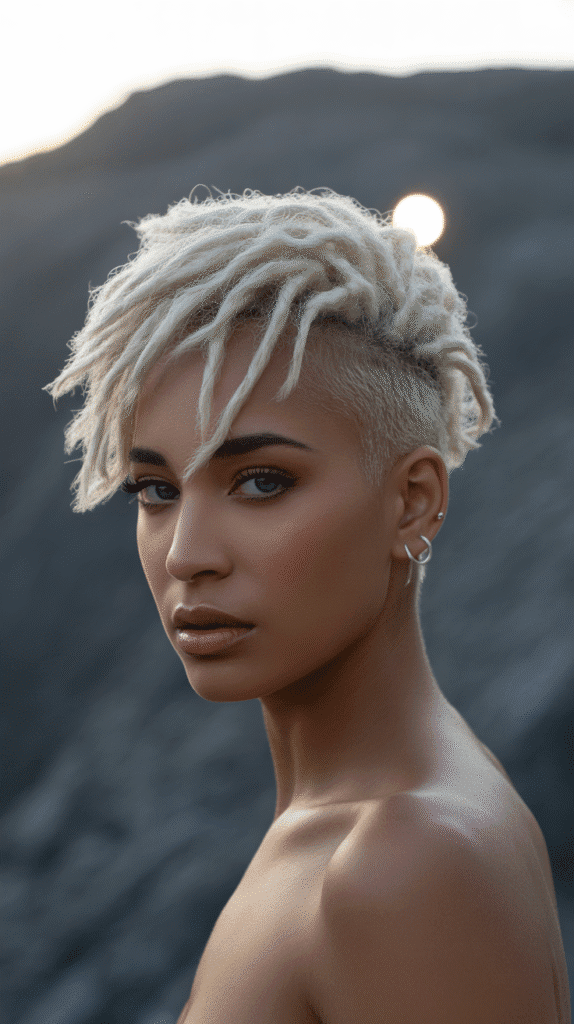
Bleached blonde short locs make a fearless fashion statement that combines the textural interest of dreadlocks with the eye-catching impact of platinum or golden blonde color.
This high-contrast style has gained tremendous popularity in recent years, offering a striking departure from natural tones while the shorter length makes the dramatic color change more manageable and less damaging to maintain.
- The bleaching process for locs requires professional expertise, as the porous nature of loc’d hair responds differently to chemical processing compared to loose natural hair.
- Short locs (under 6 inches) are ideal candidates for bleaching because the reduced length means less overall hair is exposed to chemical stress, resulting in healthier locs post-processing.
- A gradual lightening approach over multiple sessions is strongly recommended rather than attempting platinum blonde in one sitting, which can cause severe damage or breakage.
- Toner applications every 4-6 weeks help maintain the desired blonde shade and eliminate brassy or yellow undertones that naturally develop as the color oxidizes.
- Deep conditioning treatments and protein-moisture balance become critical in your hair care routine, as bleached locs require extra nourishment to maintain strength and prevent brittleness.
- The blonde color creates stunning contrast against all skin tones, though golden and honey blonde shades tend to be more universally flattering than cool platinum tones.
- Pairing bleached blonde locs with a fresh taper or undercut design amplifies the visual impact and creates a modern, fashion-forward aesthetic.
4. Short Locs with Undercut Design

Short locs with undercut design elevate the standard loc style by incorporating artistic patterns, lines, or geometric shapes carved into the closely shaved undercut section.
This fusion of traditional barbering artistry with contemporary loc culture creates a personalized statement piece that showcases both your locs’ texture and your individual style preferences.
- The undercut section can feature anything from simple parallel lines and curves to complex geometric patterns, tribal designs, or even branded logos depending on your barber’s skill level.
- Design complexity typically correlates with maintenance frequency—simpler patterns may last 2-3 weeks before growing out, while intricate designs show blur within 7-10 days.
- The placement of locs versus undercut can be customized: some prefer locs covering the entire top and crown with designs on sides and back, while others opt for more dramatic asymmetrical placement.
- This style works particularly well for those with dense, thick hair, as the undercut reduces overall volume while the remaining locs maintain visual presence.
- Regular barber visits are essential not just for design maintenance but also to keep the transition between the undercut section and loc’d area clean and well-defined.
- The undercut provides cooling relief, making this style especially popular in warmer climates or for active individuals who engage in sports or regular exercise.
- Stencils and templates can help achieve consistent, repeatable patterns if you develop a signature design you want to maintain long-term.
5. Two-Strand Twist Short Locs
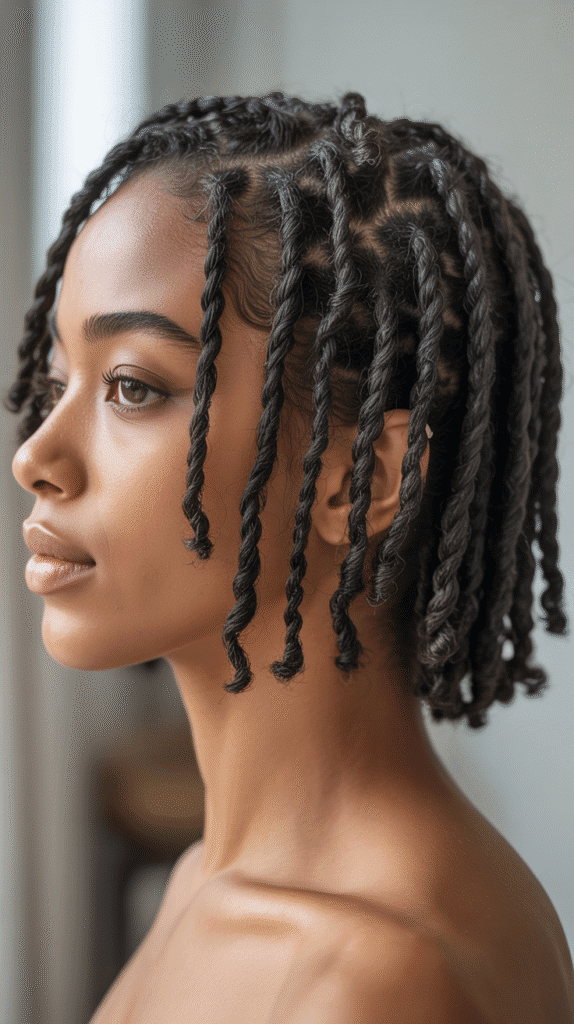
Two-strand twist short locs offer a refined, rope-like texture that distinguishes them from traditional palm-rolled or freeform locs, creating uniform spirals that catch light beautifully and provide a more manicured appearance.
This installation method involves consistently twisting two sections of hair around each other from root to tip, resulting in locs with a predictable, organized structure throughout their length.
- The two-strand twist method is one of the gentler loc installation techniques, creating less tension on the scalp compared to interlocking or tight palm-rolling methods.
- Each loc’s thickness can be customized based on the size of the initial sections, with options ranging from micro locs (pencil-thin) to chunky locs (thumb-width or larger).
- Installation time varies significantly with desired loc size and hair density, typically ranging from 3-6 hours for medium-sized locs to 8-12 hours for micro locs.
- The twisted rope texture remains visible throughout the locs’ lifespan, even as they mature and lock, creating a distinctive aesthetic different from other loc methods.
- Maintenance retwisting appointments every 4-8 weeks help manage new growth at the roots, though some people prefer to stretch this timeline to 10-12 weeks for a more mature, settled look.
- This method works exceptionally well for all hair textures, though tighter curl patterns (4A-4C) typically lock faster than looser curl patterns (3A-3C).
- The uniform appearance of two-strand twist locs makes them particularly suitable for professional environments where a neat, polished aesthetic is preferred.
6. Freeform Short Locs
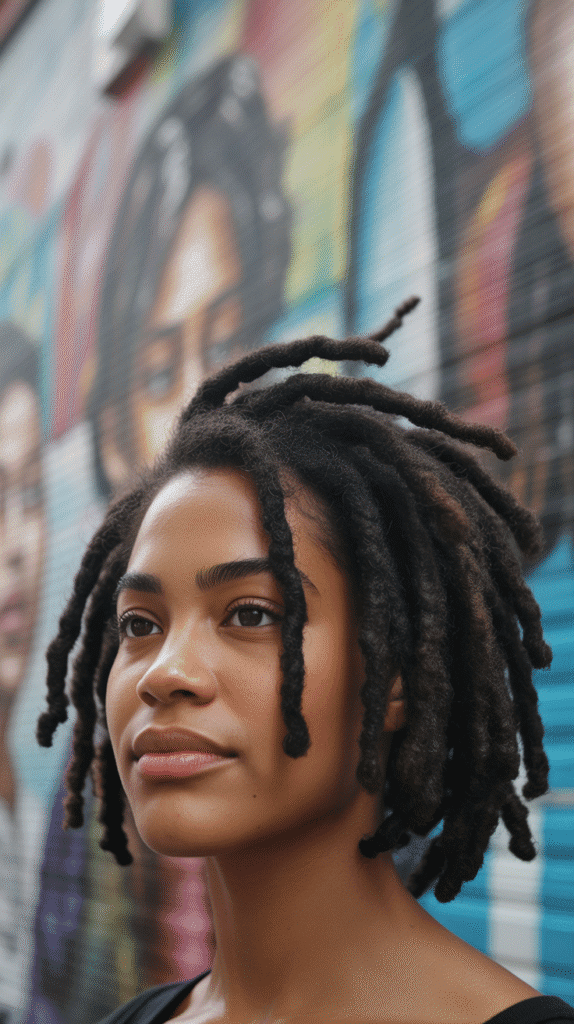
Freeform short locs embrace the organic, natural locking process with minimal human intervention, allowing hair to loc according to its own texture and pattern without regular maintenance, retwisting, or manipulation.
This philosophy-driven approach celebrates the natural journey of the hair and results in locs with varied sizes, organic shapes, and a distinctly authentic appearance that tells the unique story of your hair’s individual locking pattern.
- The freeform method requires only separation of locs during the early stages to prevent complete matting, with no palm rolling, twisting, or interlocking involved in the process.
- Starting freeform locs can be done from any hair state—loose natural hair, an existing twist-out, braids, or even a picked-out afro—as the hair will naturally begin to loc over time.
- Patience is essential with freeform locs, as the locking timeline varies dramatically based on hair texture, typically taking 6-18 months before locs are firmly established.
- The resulting locs display beautiful natural variation in thickness, some areas may form thin locs while others create thicker ones, creating an artistically irregular appearance.
- Maintenance consists primarily of regular washing with residue-free shampoo and occasional separation of locs at the roots to maintain individual locs rather than one large mat.
- Freeform locs often develop flatter, more organic shapes compared to cylindrical maintained locs, with curves, bends, and unique personality in each individual loc.
- This style particularly resonates with individuals drawn to Rastafarian culture, natural living philosophies, or those seeking a lower-maintenance loc experience.
- According to Locsanity, freeform locs can be kept neat and professional-looking with regular washing and proper separation techniques despite their organic formation method.
7. Colored Tips Short Locs
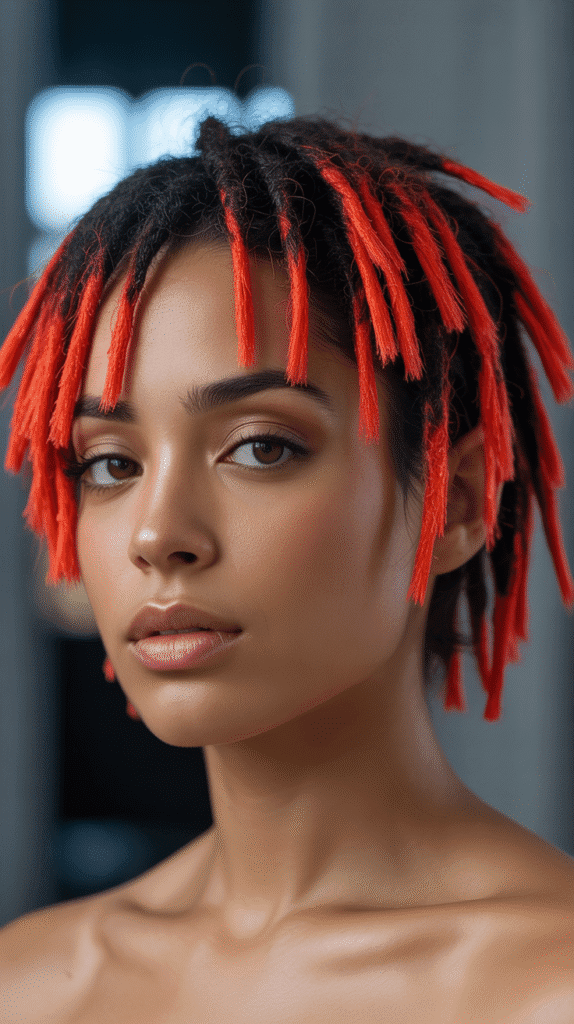
Colored tips short locs offer a playful, low-commitment way to experiment with color by applying vibrant hues only to the ends of your locs while keeping the roots and majority of the length in your natural color.
This style provides visual interest and personality without the maintenance demands or potential damage associated with all-over color treatments.
- The tips can be bleached first and then colored with semi-permanent or permanent dyes, or you can apply color directly to dark locs for a more subtle, tonal effect.
- Popular color choices include vibrant reds, electric blues, purple tones, rose gold, or even rainbow combinations for those wanting maximum visual impact.
- The shorter your locs, the more prominent the colored tips become, making this technique particularly striking on locs that are 3-6 inches in length.
- Semi-permanent color options allow you to change your tip color every 4-8 weeks as the color fades, providing ongoing experimentation without permanent commitment.
- The color placement acts as a natural “length marker” as your locs grow, showing you exactly how much new growth you’ve achieved since the initial coloring.
- Professional application ensures even color saturation throughout the porous loc’d hair structure, though many people successfully DIY this style at home with proper preparation.
- Color-treated tips require additional moisture care, including regular oil treatments and deep conditioning to prevent dryness and breakage at the colored sections.
8. Short Sisterlocks
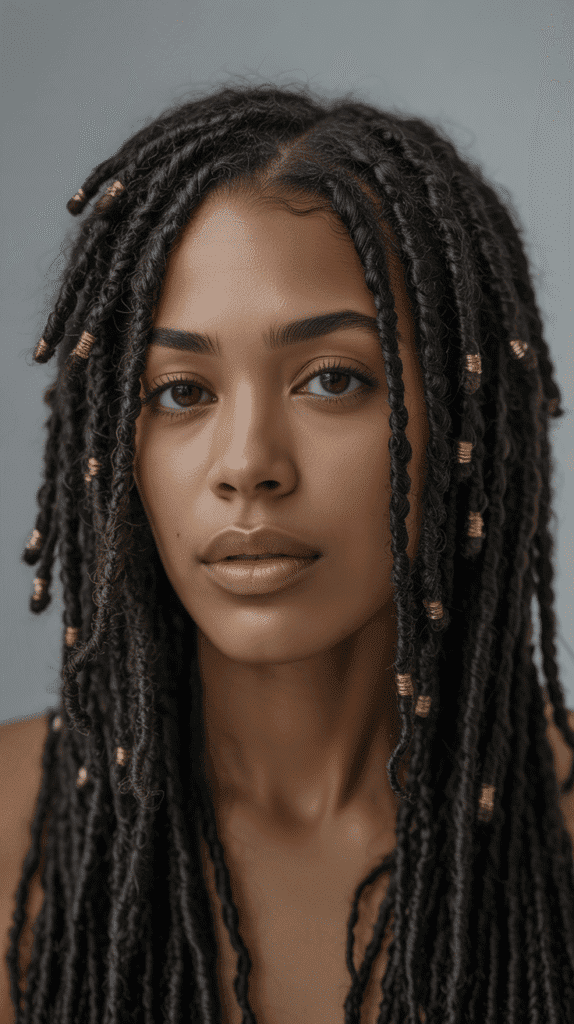
Short Sisterlocks represent a specialized locking technique that creates extremely fine, uniform locs using a precise grid pattern and specific interlocking tool, resulting in hundreds of delicate locs that offer tremendous styling versatility despite their diminutive individual size.
This patented method produces locs that most closely resemble loose natural hair in their movement and styling options while still providing the permanence and ease of locked hair.
- Sisterlocks are typically the width of a pencil lead or smaller, with the average head containing 400-600 individual locks depending on hair density and head size.
- Initial installation requires a certified Sisterlock consultant and typically takes 12-24 hours spread across multiple days, representing a significant time and financial investment.
- The ultra-fine size means short Sisterlocks (even just 2-3 inches) can be styled in numerous ways including curled, flat-ironed, set in pin curls, or worn in updos.
- Maintenance retightening appointments are required every 4-8 weeks using the specialized Sisterlock tool to interlock new growth at the roots.
- The fine grid pattern and small loc size create a fuller appearance overall, making this technique particularly appealing for those with fine or thin hair.
- Sisterlocks require no daily styling products, making them an extremely low-maintenance option despite the regular professional maintenance appointments.
- The neat, professional appearance of Sisterlocks makes them popular among professionals in corporate environments where polished aesthetics are valued.
- According to the official Sisterlocks website, this technique works on all hair textures and types, though consultation with a certified consultant helps determine if they’re right for your specific hair.
9. Short Locs with High Top
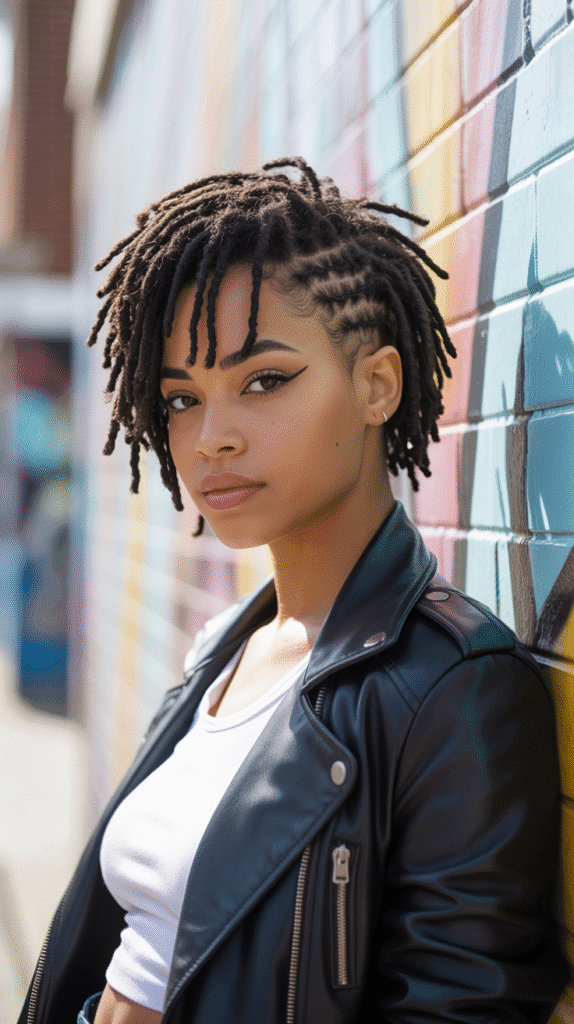
Short locs with high top revive the iconic 1980s and 90s hip-hop aesthetic by maintaining longer locs on the crown and top of the head while keeping the sides and back very short or completely shaved.
This dramatic silhouette creates maximum height and volume, making a bold statement that celebrates Black hair culture and its historical style evolution.
- The high top section typically stands 4-8 inches tall, with the locs shaped into a flat-top, rounded, or sculptural form depending on personal preference.
- Regular shaping appointments with a barber experienced in high top maintenance ensure the distinctive silhouette remains crisp and well-defined.
- This style works best with medium to thick hair density, as adequate loc volume is needed to create the distinctive high top shape.
- The dramatic height creates an elongating effect that can be particularly flattering on round or square face shapes.
- Sides and back can be maintained with a skin fade, low fade, or any length that creates clear contrast with the high top section.
- The top locs can be left freestanding, laid over, or even styled with a part line down the middle for variation.
- Modern interpretations often incorporate additional elements like undercut designs, colored tips, or asymmetrical shaping to update the classic high top aesthetic.
10. Starter Locs with Comb Coils
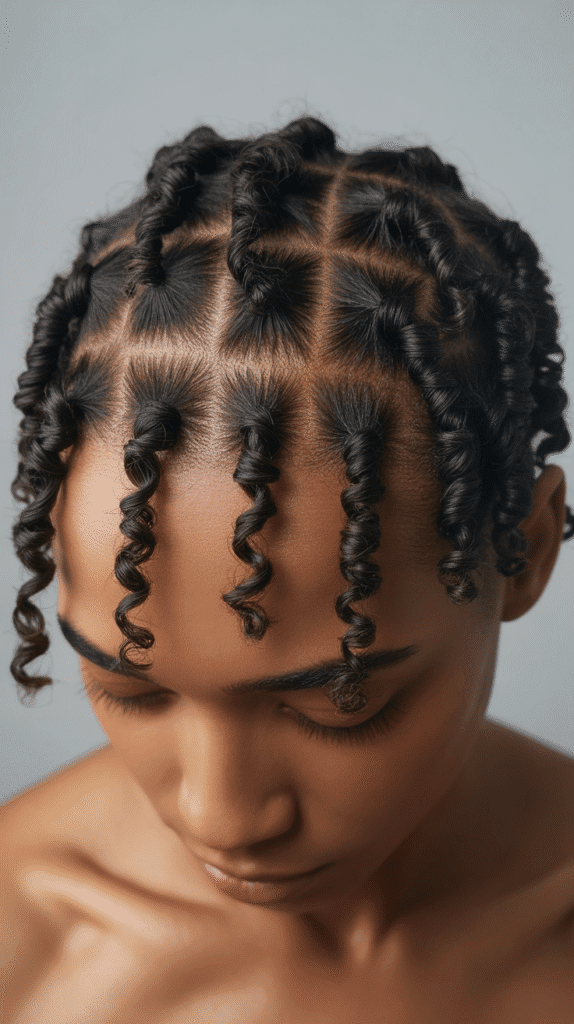
Starter locs with comb coils utilize a small-toothed comb to wrap hair tightly around itself, creating uniform, spring-like coils that provide instant definition and structure as your locs begin their locking journey.
This method is particularly popular for shorter hair (1-4 inches) and creates tighter, more compact coils than the finger coil method.
- A rat-tail comb or specialized coiling comb is twisted through small sections of hair, wrapping the hair around itself to create tight barrel coils from root to tip.
- The resulting coils are more compact and uniform than finger coils, providing a neater appearance during the starter phase when locs haven’t fully formed.
- This method works particularly well on tighter curl patterns (4B-4C hair) where the natural coil structure supports the comb coil formation.
- Comb coils typically require 3-5 hours for installation depending on desired coil size and hair density, making it a relatively quick starter method.
- A holding gel or coiling cream is essential during installation to maintain coil definition and prevent unraveling during the early weeks.
- The coils begin to lock and marry together within 2-6 months depending on hair texture, washing frequency, and individual hair characteristics.
- Maintenance involves recoiling new growth every 4-6 weeks during the first year, gradually extending to every 6-8 weeks as the locs mature and lock.
11. Asymmetrical Short Locs

Asymmetrical short locs break away from traditional symmetrical styling by intentionally creating uneven length, varied loc placement, or off-center parts that result in a fashion-forward, edgy aesthetic.
This modern approach to loc styling emphasizes individuality and artistic expression while maintaining the practical benefits of shorter dreadlocks.
- One popular asymmetrical approach features longer locs swept to one side while the opposite side maintains a shorter, faded, or even shaved section.
- The asymmetry can be subtle (a 1-2 inch difference between sides) or dramatic (one side reaching chin length while the other remains close-cropped).
- Off-center parts positioned 2-3 inches from the natural center create visual interest and draw attention to one’s best facial features.
- This style pairs exceptionally well with undercut designs, as the shaved section provides a canvas for patterns that complement the asymmetrical loc placement.
- Styling asymmetrical locs often involves directing the longer section forward across the forehead, tucking it behind one ear, or pinning it strategically to emphasize the length difference.
- The uneven nature naturally creates movement and dimension that makes the style appear more dynamic than symmetrical alternatives.
- Regular maintenance focuses on keeping the shorter sections crisp while allowing the longer sections to develop their full texture and personality.
12. Short Locs with Barrel Curls
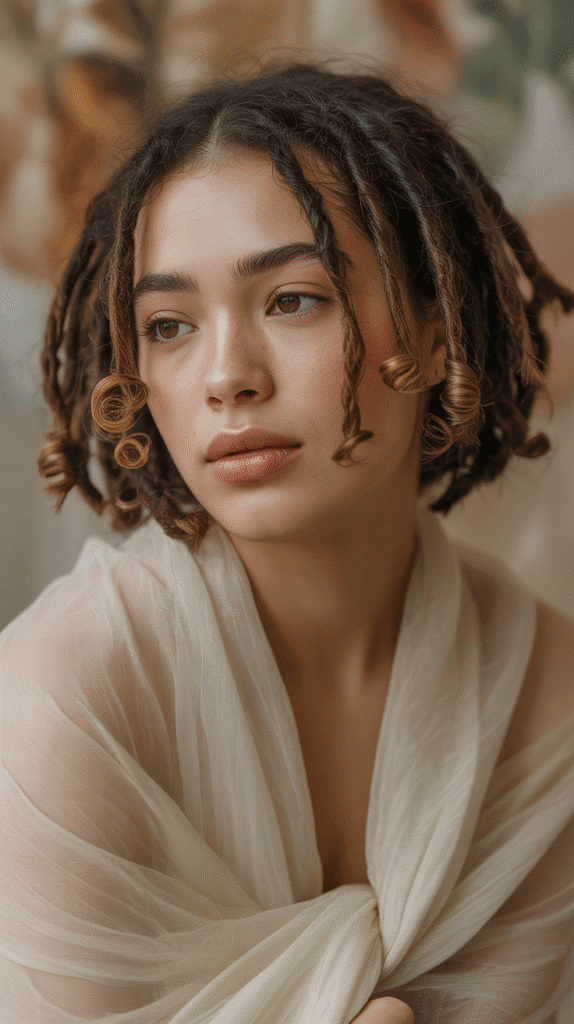
Short locs with barrel curls add romantic, feminine dimension to dreadlocks by setting the ends in smooth, cylindrical curls that create movement and soften the overall appearance.
This styling technique works beautifully for special occasions or when you want to dress up your everyday loc look with minimal effort.
- Barrel curls can be created using flexi-rods, perm rods, or even drinking straws depending on the desired curl size and your loc thickness.
- The process involves applying a setting product (mousse, loc gel, or setting lotion) to slightly dampened locs, then wrapping the ends around the rod from tip to mid-length.
- Curls set best when allowed to air dry completely (6-8 hours) or dried under a hooded dryer, with overnight setting producing the longest-lasting results.
- The resulting curls can last 1-2 weeks depending on manipulation, sleeping protection, and environmental humidity.
- Smaller rods create tighter, more defined ringlets while larger rods produce looser, flowing waves at the ends.
- This styling technique works particularly well on locs that are 3-6 inches long, providing enough length to wrap around the rod while maintaining the short loc aesthetic at the roots.
- The contrast between the textured locs and smooth barrel curls creates visual interest and dimension that photographs beautifully for special events.
13. Mohawk Style Short Locs

Mohawk style short locs channel punk rock edge through a bold strip of locs running from forehead to nape while the sides remain shaved or very closely cropped.
This rebellious style makes a powerful statement while the shorter loc length keeps the look manageable and less extreme than traditional mohawks with longer hair.
- The mohawk strip typically ranges from 2-4 inches wide, though this can be customized based on head size and desired drama level.
- Loc length in the mohawk section usually stands 3-6 inches tall, providing enough height to create the distinctive mohawk silhouette without excessive weight.
- The shaved sides can be maintained at any length from skin-bald to a short fade, with frequent barber visits (every 1-2 weeks) keeping the contrast sharp.
- Some variations include a disconnected undercut where the mohawk locs overhang the shaved sections, creating even more dramatic visual separation.
- The mohawk locs can be styled standing straight up using strong-hold gel or pomade, laid forward, swept back, or even braided down the center.
- This style works across gender presentations and is particularly popular in alternative, creative, and artistic communities.
- Color treatments in the mohawk section (vivid colors, platinum blonde, or ombre effects) amplify the punk aesthetic.
14. Short Locs with Natural Root Color

Short locs with natural root color embrace the grown-out look where colored or bleached locs show several inches of natural root growth, creating an intentional ombre or two-toned effect.
This style celebrates the beauty of transitional color while reducing the maintenance demands and chemical exposure required to keep color refreshed to the roots.
- The contrast between natural roots and colored ends typically becomes noticeable at 2-3 inches of new growth, creating a gradual color transition.
- This technique works with any color combination—natural black roots with blonde, red, burgundy, or fashion color ends.
- The grown-out look has gained fashion credibility in recent years, moving from “roots that need touching up” to “intentional stylistic choice” in mainstream beauty culture.
- Allowing roots to grow naturally reduces chemical processing frequency from every 4-6 weeks to every 3-6 months, significantly improving hair health.
- The natural roots provide a frame around the face that often proves more flattering than all-over color, particularly for those with warmer or deeper skin tones.
- Toner can be applied to just the colored sections to maintain vibrancy while leaving roots completely untouched.
- This approach is particularly practical for short locs, as the colored portion remains visible and impactful despite being a smaller percentage of the overall length.
15. Interlocked Short Locs

Interlocked short locs utilize a specialized technique where the end of each loc is pulled through the root using a tool or crochet hook, creating an extremely tight, firm foundation that produces neat, uniform locs with minimal frizz.
This method creates locs with a distinctly different internal structure compared to palm-rolled or twisted locs, resulting in a more permanent, stable loc formation.
- The interlocking pattern can be executed in different styles including the 4-point rotation method, 2-point method, or the interlocking-only-as-needed approach.
- This technique creates the firmest, most stable locs with the least amount of frizz and loosening between maintenance appointments.
- Maintenance can be stretched to 6-10 weeks or even longer once locs are established, making this one of the lowest-maintenance loc methods long-term.
- Interlocked locs typically show less visible new growth “puffiness” at the roots compared to twisted or palm-rolled locs.
- The technique works exceptionally well for very active lifestyles, swimmers, or those who wash their hair frequently, as the interlocked structure remains stable even with constant moisture exposure.
- Special care must be taken not to over-interlock, as excessive tightness can cause thinning at the roots or create a “stacked” appearance where the base becomes wider than the rest of the loc.
- Many people combine methods, using interlocking for the perimeter and nape locs while using retwisting for the top and crown sections.
16. Short Locs with Beads and Accessories
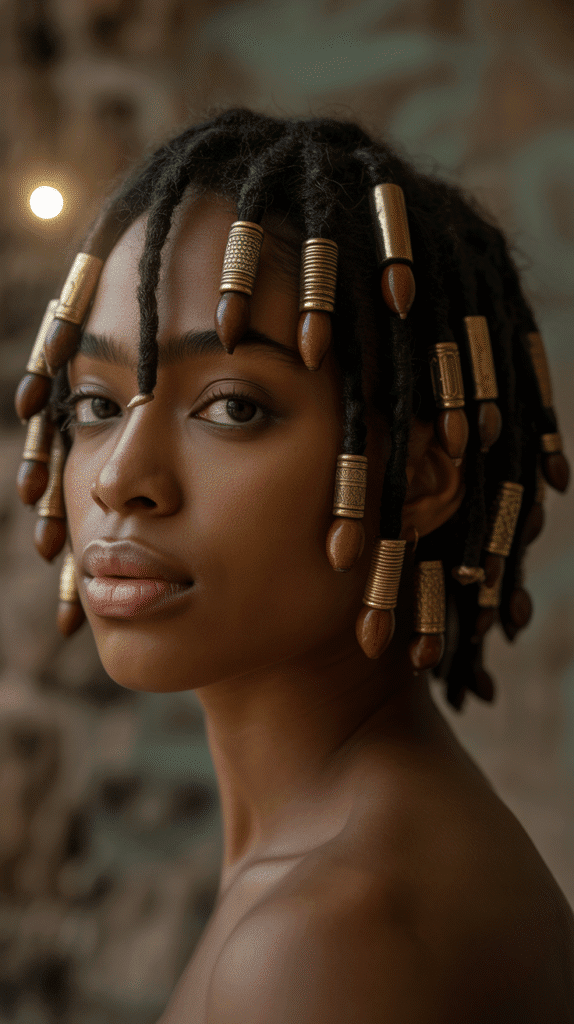
Short locs with beads and accessories transform simple dreadlocks into personalized art pieces through the addition of decorative elements like metal cuffs, wooden beads, shells, crystals, or fabric wraps.
This styling approach celebrates loc culture’s rich tradition of adornment while allowing for easy customization and personal expression.
- Beads can be threaded onto individual locs or placed at the ends, with larger beads working better on thicker locs and smaller beads suitable for micro locs.
- Metal loc cuffs slide onto locs without requiring threading, making them easy to add and remove for style changes or washing.
- The weight of accessories should be considered carefully, as excessive weight can cause stress on the root and potentially lead to thinning or breakage.
- Cultural considerations are important—certain bead colors, patterns, and materials carry specific meanings in various African and Rastafarian traditions.
- Temporary accessories allow you to change your look frequently without commitment, while semi-permanent wraps or sewn-in beads stay in place for weeks or months.
- Strategic placement creates different aesthetics: beads on the front locs frame the face, scattered beads throughout create textural interest, or beads only at the ends add movement.
- According to The Loc Lounge, wooden beads are particularly popular as they’re lightweight, don’t catch on fabric, and won’t damage the locs.
17. Tapered Short Locs with Line-Up

Tapered short locs with line-up combine the textured appeal of dreadlocks with the precision of a perfectly edged hairline, creating a polished, well-groomed appearance that reads as both stylish and professional.
The crisp line-up defines the hairline at the forehead, temples, and sideburns while the taper provides clean graduation on the sides and back.
- The line-up creates sharp, architectural edges along the hairline that frame the face and enhance facial features.
- This style requires regular barber maintenance every 1-2 weeks to keep the line-up crisp and the taper fresh, as these elements grow out quickly.
- The contrast between the sharp edges and the organic texture of the locs creates visual interest and dimension.
- Various line-up shapes are possible, from natural and subtle to dramatically angular or curved, depending on personal preference and face shape.
- The taper can be customized in height (low, mid, or high) and fade intensity (gradual or skin fade) to complement the overall aesthetic.
- This style photographs exceptionally well and maintains a neat appearance even as the locs themselves develop more mature texture and frizz.
- Proper beard grooming that echoes the line-up precision creates a cohesive, well-maintained overall appearance.
18. Burgundy or Wine-Colored Short Locs
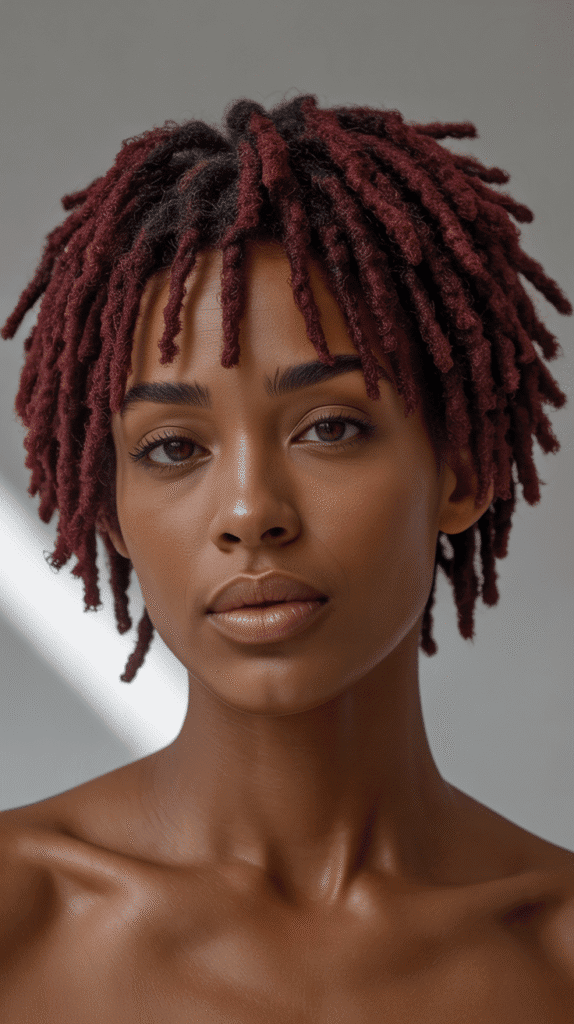
Burgundy or wine-colored short locs offer a rich, sophisticated alternative to more dramatic color choices, providing depth and dimension that complements a wide range of skin tones while maintaining a more subtle, refined aesthetic.
These deep red-purple tones catch light beautifully and add warmth without the high-contrast impact of blonde or fashion colors.
- Achieving true burgundy or wine tones typically requires pre-lightening dark hair to at least a medium brown level before applying the color.
- These rich tones are particularly flattering on warm and neutral undertones, creating a harmonious color story that enhances natural complexion.
- The color depth means root growth is less dramatically noticeable compared to lighter colors, allowing for extended time between color touch-ups (8-12 weeks).
- Both permanent and semi-permanent options exist, with semi-permanent providing vibrant color that gradually fades to softer tones over 4-8 weeks.
- Burgundy tones can be customized from deep, almost-black wine to brighter cherry-red burgundy depending on the desired intensity.
- Color-depositing conditioners in red or burgundy tones help maintain vibrancy between professional coloring appointments.
- The color appears different in various lighting conditions—deeper and more subtle in indoor lighting, vibrant with red undertones in natural sunlight.
19. Short Locs with Sponge Technique
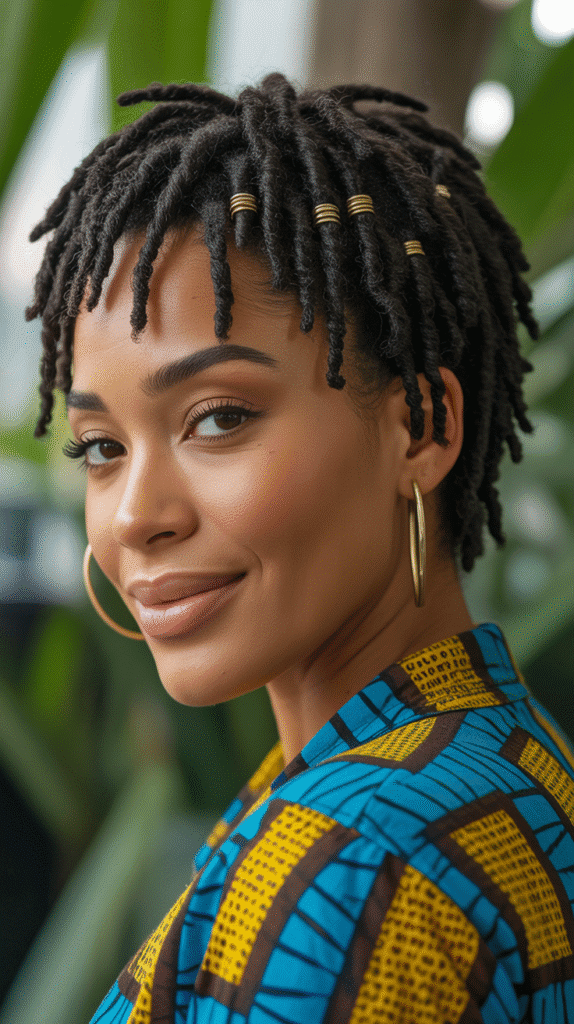
Short locs with sponge technique utilize a specialized hair sponge (also called a loc sponge or curl sponge) with holes or grooves to create uniform, defined coils in very short hair, offering an easy DIY method for starting locs or maintaining definition in established short locs.
This technique has gained massive popularity for its simplicity and consistent results.
- The sponge is rubbed in circular motions over damp, product-enhanced hair, with the holes catching and twisting the hair into uniform coils.
- This method works best on hair that’s 1-3 inches long, making it ideal for the very early stages of the loc journey or for maintaining short locs.
- Different sponge styles create different coil patterns—larger holes create thicker, looser coils while smaller holes produce tighter, more numerous coils.
- The entire process takes just 10-20 minutes, making it one of the fastest methods for creating or refreshing loc definition.
- A light holding product like loc gel or moisturizing cream applied before sponging helps set the coils and reduces frizz.
- Results typically last 3-7 days depending on hair texture, activity level, and sleeping protection methods.
- This technique is particularly popular with men and those seeking a casual, low-maintenance short loc style.
20. Short Locs with Side Part
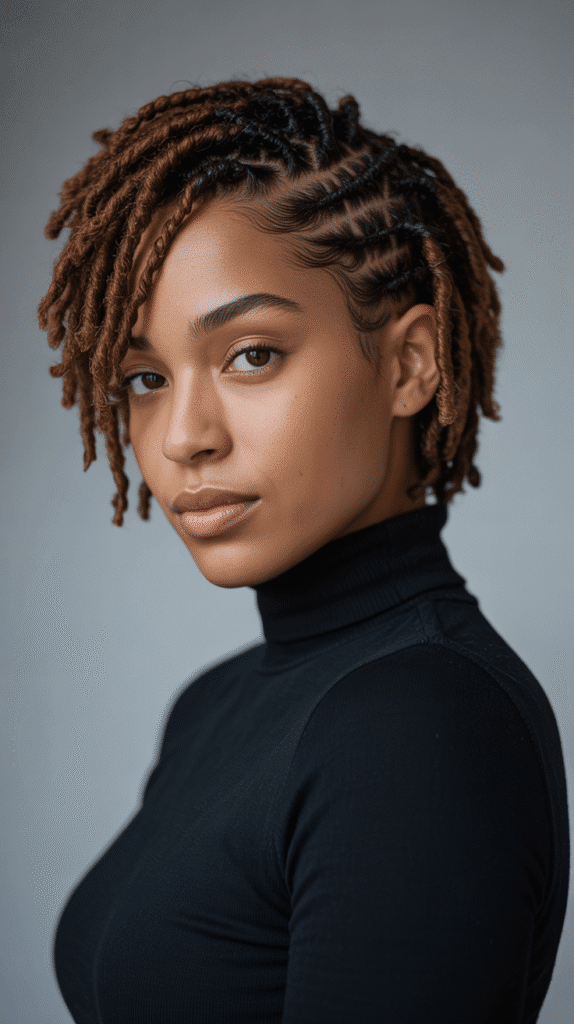
Short locs with side part introduce classic, timeless elegance to dreadlocks by creating a defined part line several inches from center, allowing locs to sweep gracefully to one side while creating volume and dimension.
This versatile style works across professional and casual settings while being remarkably easy to maintain.
- The part can be positioned anywhere from 1-4 inches from the natural center, with deeper side parts creating more dramatic asymmetry.
- A clean, straight part line can be maintained with regular retwisting appointments where the stylist carefully separates and redirects the locs.
- The heavier side with more locs creates natural volume and fullness, while the lighter side appears sleeker and closer to the head.
- This style particularly flatters oval and heart-shaped faces by creating asymmetrical visual interest that draws the eye.
- The side part can be changed periodically to prevent permanent part lines from developing in the scalp if desired.
- Styling products are rarely necessary as the locs’ weight naturally keeps them in place once directed to the preferred side.
- The swept-over locs can be tucked behind the ear on the lighter side for a polished, professional appearance or left forward for a more casual, tousled look.
21. Micro Short Locs
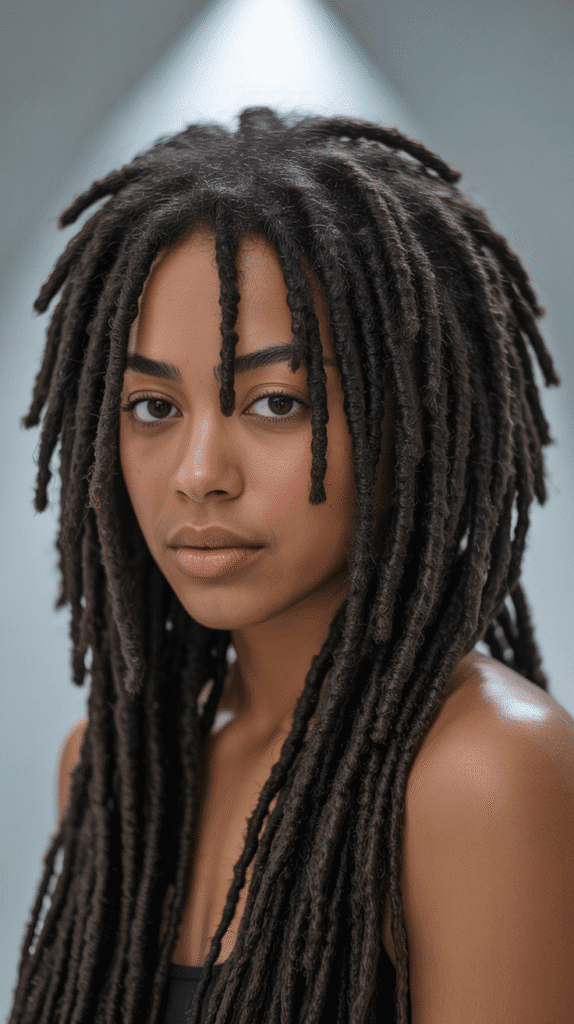
Micro short locs feature extremely thin individual locs, typically pencil-width or smaller, resulting in hundreds of delicate locs that provide exceptional styling versatility and a fuller overall appearance.
This precision approach to loc’ing creates a refined, polished aesthetic even at short lengths while opening up numerous styling possibilities typically associated with loose natural hair.
- Micro locs typically range from 250-700+ individual locs depending on head size, hair density, and desired loc thickness.
- Initial installation is time-intensive, requiring 12-30 hours spread across multiple days, with the investment paying off in long-term versatility.
- The thin diameter means micro locs can be curled, braided, styled in intricate updos, or manipulated in ways that thicker locs cannot achieve.
- Maintenance appointments occur every 4-8 weeks and may be more time-consuming than traditional loc maintenance due to the sheer number of locs requiring attention.
- Micro locs create the illusion of fullness, making this technique particularly appealing for those with fine or thin hair.
- The installation method can vary—interlocking, braiding, two-strand twists, or Sisterlocks technique—each creating slightly different textures and loc characteristics.
- Daily styling
22. Short Locs with Twist-Out Ends
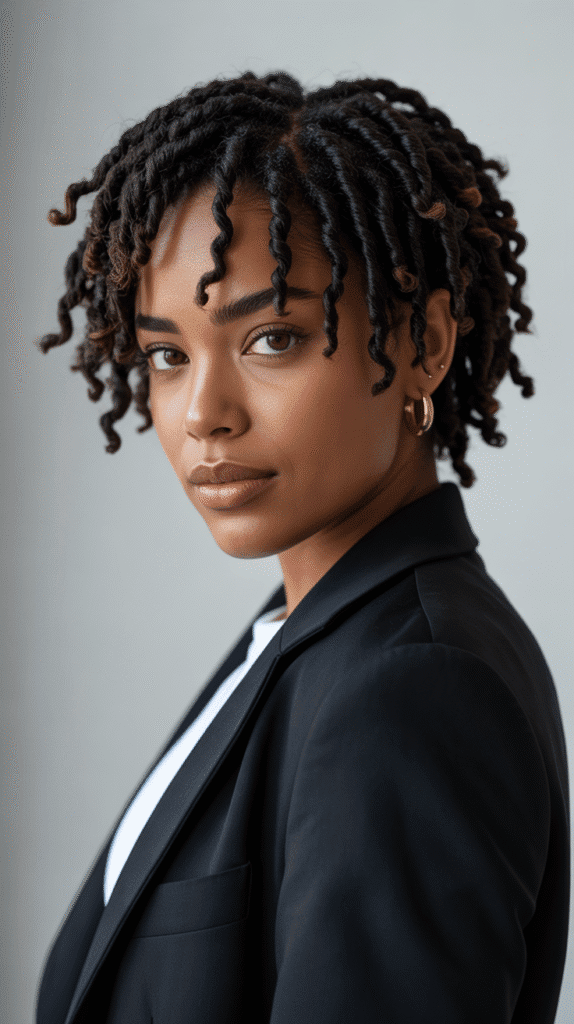
Short locs with twist-out ends combine the structured permanence of locked roots with the soft, defined curl pattern of twisted ends, creating a beautiful textural contrast that adds femininity and movement to short dreadlocks.
This styling technique offers the best of both worlds—the low maintenance of locs with the versatility of styling the ends.
- The technique involves two-strand twisting the last 1-2 inches of each loc on damp hair with a setting product, then allowing them to dry completely before unraveling.
- The resulting twist-out creates defined, springy curls at the ends that soften the overall appearance and add dimension.
- This style works best on locs that are at least 3-4 inches long, providing enough length to twist and create visible curl definition.
- The twist-out ends typically last 3-7 days depending on humidity, manipulation, and nighttime protection methods.
- Setting on flexi-rods or perm rods instead of simple two-strand twists creates tighter, more uniform curls with longer-lasting definition.
- The style offers easy versatility—you can wear the twist-out loose, gather the locs into a puff or ponytail, or pin sections up while leaving others down.
- Refreshing involves lightly misting the ends with water and setting product, then re-twisting only the sections that have lost definition rather than the entire head.
23. Ombre Short Locs
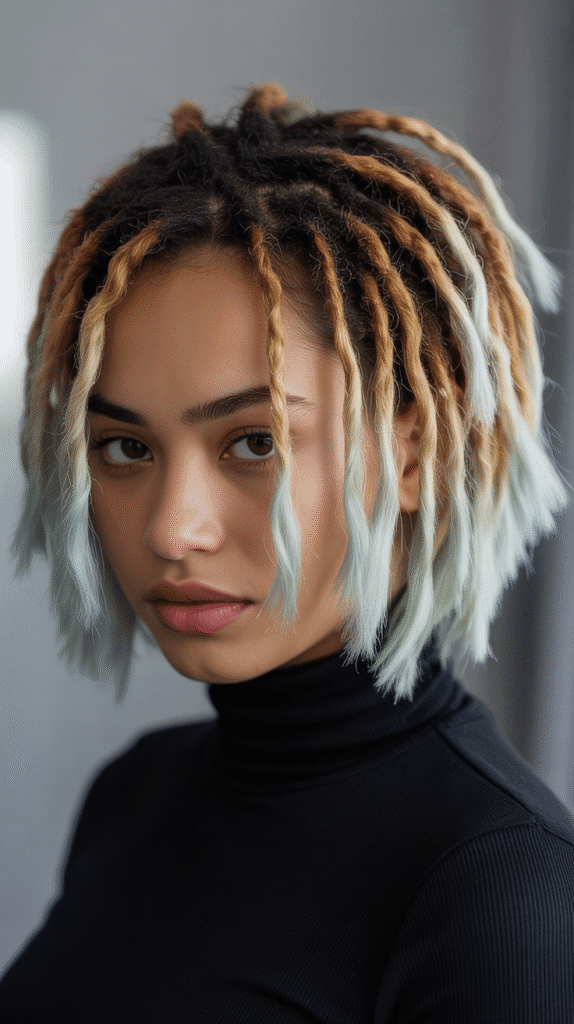
Ombre short locs feature a gradual color transition from darker roots to lighter ends, creating dimensional, multi-tonal color that adds depth and visual interest without requiring frequent root touch-ups.
This coloring technique has become increasingly popular as it offers the impact of color with significantly reduced maintenance compared to all-over coloring.
- The color transition typically begins at the mid-length of the locs, gradually lightening toward the ends for a natural, sun-kissed appearance.
- Popular ombre combinations include natural black to caramel, dark brown to honey blonde, or even dark bases with vibrant fashion colors at the ends.
- The gradual transition requires professional color application to avoid harsh lines or uneven color distribution through the porous loc structure.
- On short locs (3-6 inches), the ombre effect is more compressed, creating a bolder, more dramatic transition compared to the subtle fade seen on longer locs.
- Maintenance focuses primarily on toning and refreshing the lighter ends every 6-8 weeks while leaving the darker roots completely untouched.
- The growing-out process is virtually invisible with ombre coloring, as new growth simply extends the darker root section naturally.
- Deep conditioning treatments should concentrate on the colored ends where the hair is most vulnerable to dryness and damage.
24. Short Locs with Temple Fade
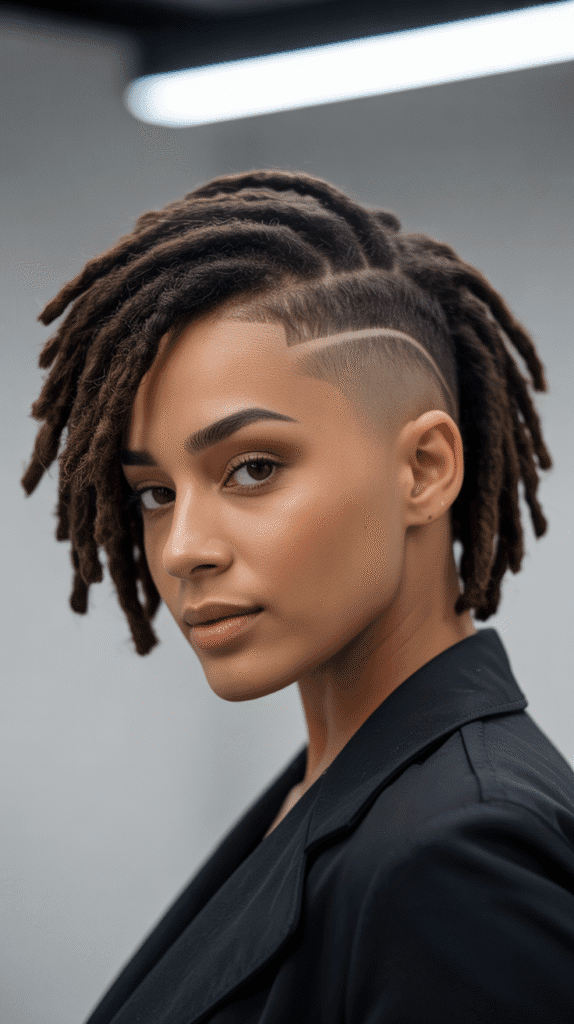
Short locs with temple fade focus the fade specifically on the temple areas while maintaining more length on the sides and back compared to a full taper, creating a subtle yet impactful style that draws attention to the face and creates a clean, modern silhouette.
This targeted approach offers definition without the dramatic contrast of an all-over fade.
- The temple fade gradually tapers the hair at the temples from the hairline back 2-4 inches, creating a clean frame around the face.
- This style maintains more hair on the sides and back compared to a full taper, making it ideal for those who want definition without exposing too much scalp.
- The fade can be customized from a subtle, gradual temple taper to a more dramatic skin fade specifically at the temple points.
- Regular maintenance every 2-3 weeks keeps the temple fade crisp, though the sides and back require less frequent attention.
- The temple fade pairs particularly well with a line-up, as both elements work together to create facial framing and structure.
- This style offers professional polish while maintaining more coverage than full tapers or fades, making it suitable for conservative work environments.
- The temples-only approach means less dramatic temperature differences or sun exposure compared to styles with extensively shaved sides.
25. Chunky Short Locs
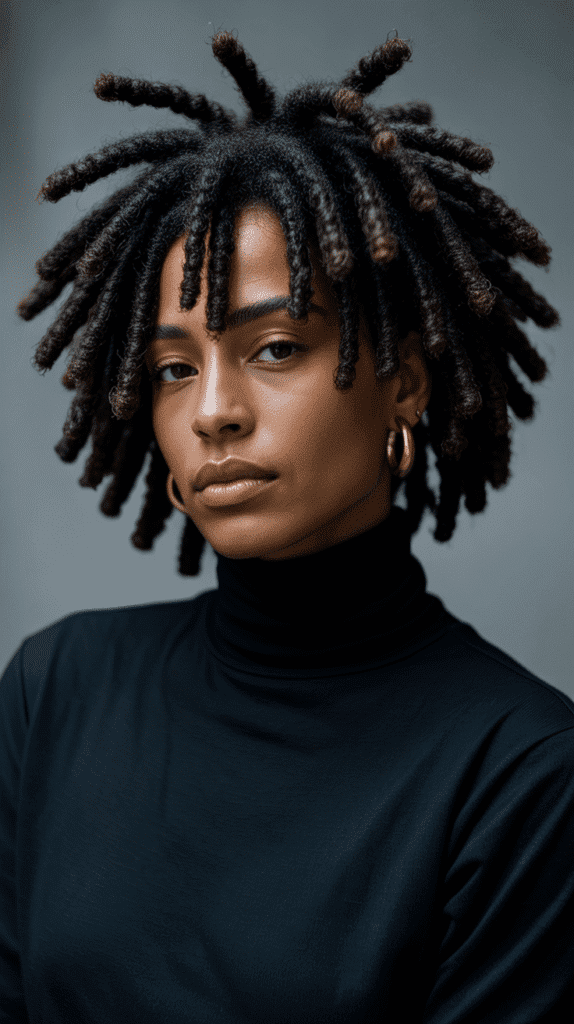
Chunky short locs feature intentionally thick, substantial individual locs—typically thumb-width or larger—that create a bold, statement-making aesthetic with fewer overall locs to manage.
This approach offers a distinctly different visual compared to traditional medium-sized locs, with each individual loc carrying significant presence and personality.
- Chunky locs typically result in 30-80 total locs on the head depending on hair density and desired thickness, dramatically fewer than traditional loc counts of 100-300+.
- The thick diameter means chunky locs lock and mature more quickly than thinner locs, often reaching a semi-mature state within 6-12 months.
- Installation is significantly faster than traditional or micro locs, often taking just 2-4 hours to section and begin the locking process.
- Maintenance appointments are equally efficient, as fewer locs mean less time spent retwisting, interlocking, or palm-rolling.
- The substantial size creates bold visual impact even at short lengths, with 3-4 inch chunky locs appearing more dramatic than 6-7 inch traditional locs.
- Chunky locs work particularly well for those with thick, dense hair, as the large sections accommodate the hair volume comfortably.
- Styling options are somewhat limited compared to thinner locs, but the bold aesthetic makes a strong statement even when worn simple and loose.
26. Short Locs with Highlights
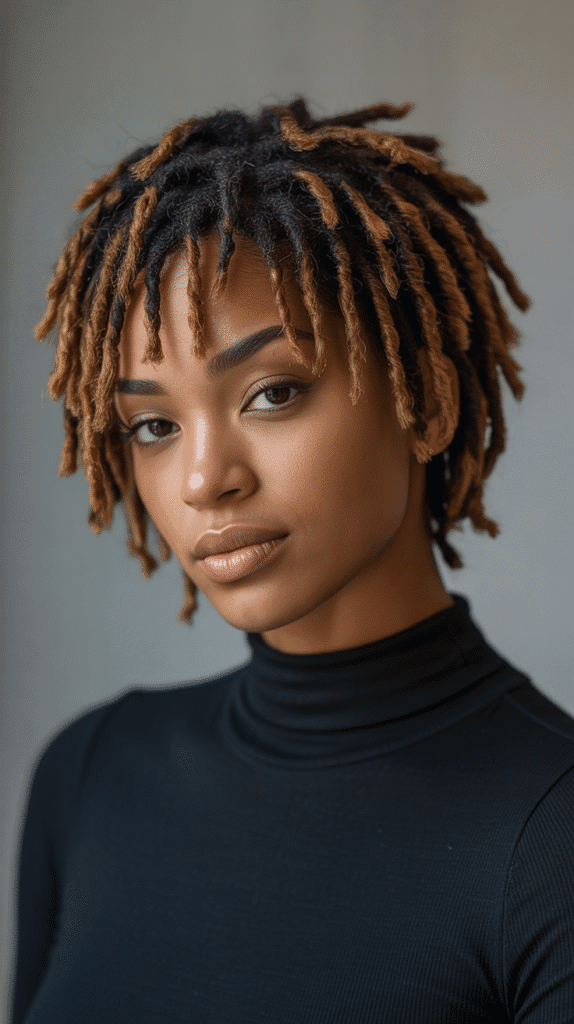
Short locs with highlights incorporate strategic lighter color placement throughout the locs rather than all-over color, creating dimension, movement, and visual interest through contrast.
This technique adds sophistication and modernity to dreadlocks while requiring less maintenance than full-color treatments.
- Highlights can be applied as traditional foil highlights, balayage-style hand-painted sections, or by selecting specific locs to lighten while leaving others natural.
- Popular highlight placements include face-framing locs, crown highlights that catch light, or scattered highlights throughout for all-over dimension.
- The number of highlighted locs can vary from subtle (10-20 locs for just a hint of dimension) to bold (50+ locs for dramatic contrast).
- Caramel, honey, and golden blonde highlights are universally flattering and create warmth, while ash and platinum tones offer cooler, edgier aesthetics.
- The highlighted locs require the same extra moisture care as all-over color, but the majority of locs remain in healthy, unprocessed condition.
- Highlight placement can be adjusted at each color appointment to prevent the same locs from being repeatedly processed and potentially damaged.
- On short locs, even minimal highlighting creates significant visual impact as the lighter color is concentrated in a smaller area.
27. Short Locs with Loc Extensions

Short locs with loc extensions provide instant length, volume, or color without waiting for natural growth or committing to permanent changes.
This technique attaches pre-made or custom-created loc extensions to existing short locs, offering dramatic transformation possibilities while protecting the natural locs underneath.
- Extensions can be attached using various methods including wrapping, braiding, interlocking, or using crochet techniques, with method choice depending on natural loc maturity.
- The extensions should match or closely approximate the thickness of your natural locs to create a seamless, natural-looking blend.
- Human hair loc extensions can be styled with heat, colored, and manipulated like natural locs, while synthetic options are more affordable but less versatile.
- Installation typically takes 4-8 hours depending on how many extensions are being added and the attachment method used.
- Loc extensions can remain installed for 2-3 months before requiring maintenance to reattach any loosened extensions and incorporate new growth.
- This technique allows you to experiment with length, color (through pre-colored extensions), or thickness without committing to permanent changes to your natural locs.
- Proper care includes regular washing with the extensions in place, careful manipulation to avoid pulling at the attachment points, and nighttime protection with a satin bonnet or pillowcase.
Maintenance Tips for Short Dreadlocks
Maintaining short dreadlocks properly ensures they remain healthy, neat, and stylish throughout their development and maturity.
Short locs offer unique maintenance advantages—they dry faster, require less product, and are generally easier to manage than longer lengths—but they still benefit from consistent, informed care practices.
Basic Washing Routine
- Wash short locs every 7-14 days using a residue-free shampoo specifically formulated for locs or clarifying shampoos that won’t leave buildup.
- Focus shampooing efforts on the scalp where oil and product accumulate, allowing the lather to cleanse the locs as you rinse.
- Short locs dry significantly faster than longer lengths, typically air-drying completely within 2-4 hours, reducing the risk of mildew or musty odors.
- Some people prefer washing more frequently (every 3-5 days), which is perfectly fine for short locs as they handle moisture exposure better than longer, denser locs.
Retwisting and Root Maintenance
- Schedule maintenance appointments every 4-8 weeks depending on your loc method, hair growth rate, and desired neatness level.
- Some people prefer to stretch retwisting to 10-12 weeks for a more mature, organic appearance with visible texture at the roots.
- Use light to medium hold products during retwisting to avoid product buildup that can create residue and dullness.
- Palm rolling, interlocking, or two-strand twisting at the roots helps incorporate new growth and maintain loc structure.
Moisture and Scalp Care
- Apply light oils (jojoba, coconut, or grapeseed) to locs and scalp 2-3 times weekly to prevent dryness without causing buildup.
- Water-based loc sprays provide daily moisture refresh without heaviness, particularly important for short locs that can appear dry more easily.
- Scalp massages stimulate blood flow and promote healthy hair growth while distributing natural oils throughout the roots.
- Deep conditioning treatments every 2-4 weeks provide intensive moisture, particularly important for colored or chemically treated locs.
Nighttime Protection
- Satin or silk bonnets, durags, or pillowcases prevent friction that can cause frizz and preserve moisture in the locs overnight.
- Short locs are less prone to flattening than longer lengths, making nighttime protection easier and less bulky.
Style Maintenance
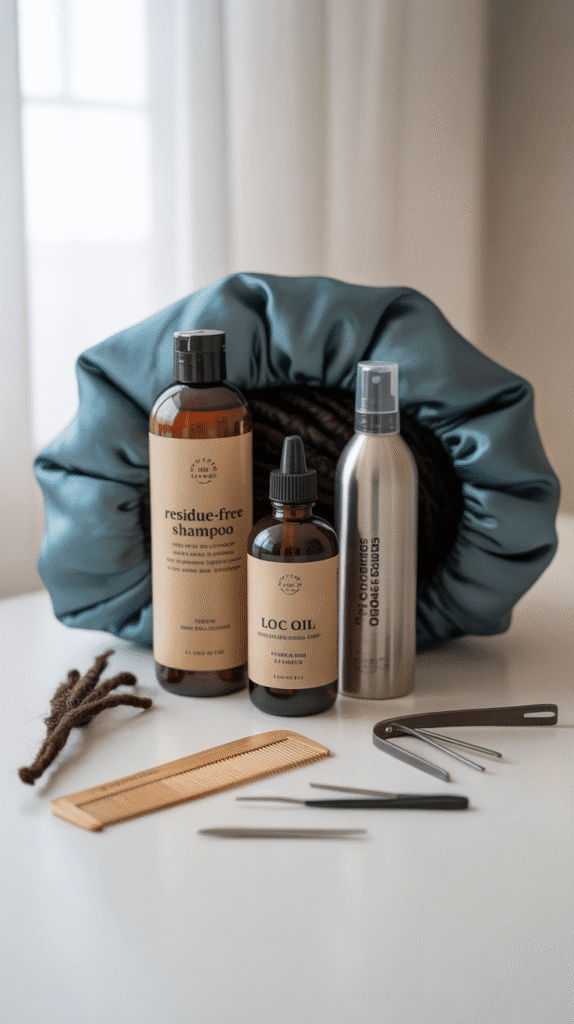
- Refreshing styled looks (twist-outs, barrel curls) with light misting and product extends the life of styles between washes.
- For tapers, fades, and undercuts, barber visits every 1-3 weeks maintain the crisp contrast that makes these styles striking.
Choosing the Right Short Loc Style for Your Face Shape
Selecting a short dreadlock style that complements your face shape enhances your natural features and creates visual harmony. Understanding how different loc styles interact with facial proportions helps you make informed decisions that result in a flattering, balanced appearance.
Oval Face Shapes
- Oval faces are proportionately balanced and work well with virtually any short loc style from symmetrical to asymmetrical designs.
- High tops, mohawks, and styles with added height complement oval faces without creating disproportion.
- Both tapered sides and fuller styles work equally well, making oval the most versatile face shape for loc experimentation.
Round Face Shapes
- Styles with height on top (high tops, mohawk locs) create vertical lines that elongate round faces and add length.
- Asymmetrical styles and deep side parts break up the roundness and create visual interest through diagonal lines.
- Avoid styles that add width at the sides, instead opting for tapered or faded sides that keep volume concentrated at the crown.
- Temple fades and clean line-ups create definition and structure that complements softer facial features.
Square Face Shapes
- Softer styling like twist-out ends or barrel curls balances angular jawlines and adds feminine movement.
- Styles with volume on top draw attention upward and elongate the face, softening the square proportions.
- Side parts and asymmetrical designs introduce curves that contrast with angular features.
- Avoid blunt, harsh lines that echo the square jaw; instead choose graduated tapers and softer transitions.
Heart-Shaped Faces
- Fuller styles at the temples and sides balance wider foreheads and narrower chins characteristic of heart shapes.
- Avoid excessive height on top that emphasizes forehead width; instead choose moderate volume with fuller sides.
- Side-swept styles and asymmetrical designs draw attention diagonally, creating balance across the face.
- Loc styles that come forward slightly at the temples (rather than fully exposing them) create proportional harmony.
Long/Rectangular Face Shapes
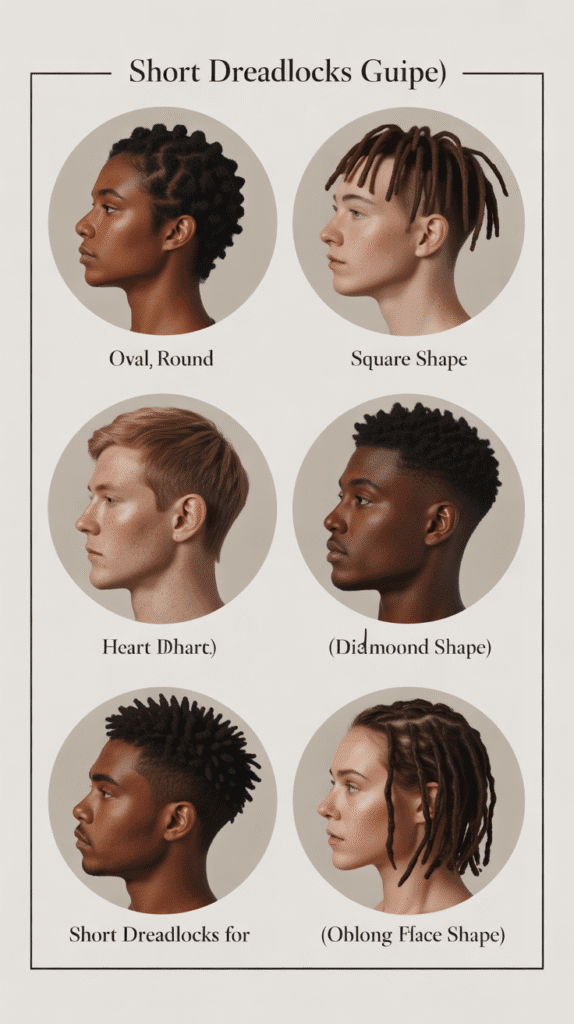
- Width-adding styles like fuller sides without excessive top height create balanced proportions.
- Avoid very tall styles (extreme high tops) that further elongate long faces.
- Side-swept locs, fuller temple areas, and styles that extend outward rather than upward create width and balance.
- Horizontal lines and asymmetrical elements break up vertical length visually.
Conclusion
The world of short dreadlocks offers remarkable diversity, proving that limited length doesn’t mean limited style possibilities.
Throughout this exploration of “27 Latest Short Dreadlock Styles That Are Easy and Stylish,” we’ve journeyed through classic approaches like tapered fades and finger coils, bold statements such as mohawks and asymmetrical cuts, sophisticated color treatments from subtle highlights to dramatic bleached blonde, and cultural expressions through beaded accessories and freeform philosophies.
Each style presented addresses different aesthetic preferences, lifestyle needs, and hair care capabilities, ensuring that everyone can find an approach that resonates with their personal identity and practical requirements.
Short locs deliver tangible benefits beyond their visual appeal—faster drying times reduce the risk of mildew, lighter weight minimizes strain on roots and edges, styling requires less time and product, and professional maintenance appointments are often shorter and less expensive than those required for longer lengths.
Whether you’re drawn to the precision of Sisterlocks, the boldness of a bleached blonde taper, the organic beauty of freeform locs, or the artistic expression of undercut designs with beaded accessories, the short dreadlock styles showcased here demonstrate that embracing shorter lengths opens doors to creativity, convenience, and confident self-expression.
As you move forward in your loc journey or contemplate beginning one, remember that the best style is always the one that makes you feel authentically yourself—the one you can maintain consistently, that complements your lifestyle, and that brings you joy each time you see your reflection.
